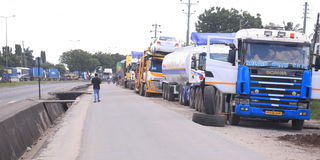Prime
How roadside lorries have become a nuisance in Tanzania

What you need to know:
- Economic analysts emphasise that parking lorries on the roadsides has economic consequences, causing traffic jams that delay work
Dar es Salaam. The commercial hub of Tanzania is grappling with a growing problem of hundreds of lorries clogging its service roads every day when loading and unloading cargo.
From Tabata Mwananchi to the Dar port, from Kilwa Road to Morogoro Road, the story is the same—a sea of lorries with the wheels grinding against the pavement, their presence a solid force against the flow of daily life.
This situation not only poses a nuisance to residents in other areas, but also affects places adjacent to the offices of the Tanzania National Roads Agency (Tanroads), the authority responsible for road maintenance and protection. Lorries line up even in this very place, contrary to road signs warning against parking on road reserves.
The Road Traffic Act of 2007 explicitly prohibits any activities on road reserves. “Road reserves are specifically for road development and expansion or any activities related to roads,” states Section 29(1) of the law.
“It’s like a maze out there,” laments Juma Munira, a resident of Segerea, one of the many voices drowned out by the harshness of congestion. “Lorries park everywhere, turning our streets into a battleground for space.”
But, who is to blame for this urban nuisance? Some point fingers at the lorry owners, accusing them of flouting the law with impunity. “It’s a nuisance, plain and simple,” states Ms Monicah Juma, a victim of the chaos. “Accidents are waiting to happen; it is all because of a few lorry owners and drivers breaking the rules.”
Yet, the owners of lorries offer a denial: “We’re not to blame here,” asserts the Chairperson of the Association of Small and Medium Truck Owners (Tamstoa), Mr Chuki Shabani.
“Dar es Salaam lacks enough parking spaces, leaving us with no choice but to find spaces in the streets. We have talked a lot about the issue of allocating parking spaces for trucks entering and leaving Dar es Salaam,” he said. “We have met with the government in meetings and raised this issue, and we have already proposed an area in Kibaha (Misugusugu), but we see no response,” he added.
However, the head of Planning Department at Tanroads in Dar es Salaam, Mr Clever Akilimali, acknowledged the challenge, explaining, however, that they have been addressing it by preventing such actions and educating lorry owners and drivers.
“Legally, parking vehicles on the roadside is not allowed because it damages the road. This situation has emerged in many areas. We at Tanroads are prohibiting it and ensuring that we provide enough education,” he said.
“These actions have increased mostly on the outskirts of the city or near areas with Inland Container Depots (ICDs). In recent months, there has been a challenge, and we sat down with district leaders and removed those vehicles,” he added. He urged drivers to stop parking vehicles on the roadside for safety reasons, including preserving road quality. However, he did not elaborate on the enforcement of the law.
Meanwhile, urban planning experts acknowledge the challenge, attributing it to the lack of consideration for parking areas for lorries in city planning.
An Urban Planning Officer and lecturer at the Planning College, Mr Gerald Temu, stated that the problem arises from a lack of priority for lorry parking in city and town plans.
“Our city planning leaders do not seem to prioritise parking areas for lorries; it seems to be overlooked. This is a new demand driven by the growth of the transportation sector,” he said.
“This is a new challenge for a city like Dar es Salaam. Even in their first comprehensive plan and in the revisions, I am not sure if they considered these areas.”
Mr Temu noted that even in areas designated for lorry parking, the infrastructure remains unfriendly. His remarks align with the reality of the Dar es Salaam Master Plan (2012-2032), which did not explicitly address truck parking.
The key recommendations in the 20-year plan include institutional reform, Dar es Salaam Municipal Council structure, government relations, financing, community participation, monitoring, compliance, informal settlements and legal reforms. Economic analysts emphasise that parking lorries on the roadsides has economic consequences, causing traffic jams that delay work.
“When traffic jams are severe, people are delayed in their work, thus reducing productivity. Moreover, in simple terms, traffic jams consume fuel, so there must be some pain,” said economic expert Mark Patrick.
Mr Patrick added that if production obstacles are removed from Dar es Salaam, efficiency will be evident in Tanzania’s economy as a whole, given its status as a trading hub in East Africa.




